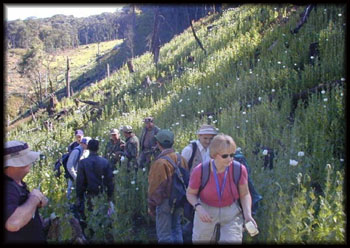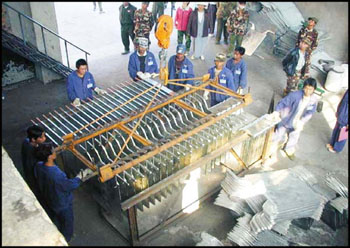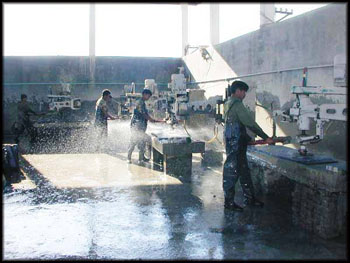|
|
Myanmar-US Combined Team Conducts
Ninth Opium Yield
Survey towards Eradication of Narcotic Drugs
|
24-2-03: Kyauk-ka-char village, Ho Pone Township-Southern Shan State
|

24-2-03: Lwe-Toe
village,Mong Pyine Township-Eastern Shan State
In
accordance with the programme towards the eradication of narcotic drugs and
psychotropic substances being implemented in collaboration by the governments of
Myanmar and the United States of America, a combined Myanmar – US team led by
member of the Central Committee for Drug Abuse Control (CCDAC) of Myanmar
Brigadier General Kyaw Thein set out on 24 February 2003 and conducted an Opium
Yield Survey till 3 March 2003 in Hopong Township in Shan State (South); in
Mongpyin, Mongkhat, Mongpauk and Kyaintong townships in Shan State (East); in
Kutkai and Kunlong townships and the Laukkai and ‘Wa’ regions in Shan State
(North). The combined team visited far-flung, isolated and highly inaccessible
regions by military helicopter to conduct a survey of illegal opium poppy cultivation
plots and to gather poppy bulbs and poppy leaf samples as part of the survey.
The team also interviewed the poppy farmers in the respective regions and
inspected opium poppy cultivation plots that had been destroyed.
|
24-2-03: Lwe-Toe village,Mong Pyine Township-Eastern Shan State
|
25-2-03:Nar-phue village,Kyainge Tong Township-Eastern Shan State |
During
their tour, the team visited the Special Region No: 2 of the ‘Wa’ region in Shan
State (East) and observed the Wan Hon Agriculture Farm, the Loi Hsanhson Opium
Hill coffee plantation and tea plantation. Their tour of observation also
included a visit to the Kyaintong-Mongzin Pig Farm and Feed Factory as well as
the ‘Wa’ Alternative Development Project -(WADP) being undertaken by the United
Nations Office on Drug Control and Crime (UNODC) in the Mongphyan region. Next
on the itinerary were the Lonhtan Tin Processing Factory, the opium substitute
tea cultivation plot in Mongmaw Region, the Granite Factory, tea factory, the
Longan, lychee, and mango orchards and the opium substitute soy bean cultivation
plot and other development projects being carried out in Shan State (North) No:
2 Special Region.
|
25-2-03:Nar-phue village,Kyainge Tong Township-Eastern Shan State |
25-2-03:Wan Hon,WA Region-Eastern Shan State |
The team also went on a tour of the Lashio Coffee Nursery
and Plantation, the Model Pig and Poultry Farm , the Distribution
of High quality Bonmon Hsin Shweli corn seeds, the apiculture farm, and the
Naungmon honey orange orchard being implemented under the sponsorship of the North-Eastern Military Command. The next stop was the No: 1 Special Region of Laukkai in Shan State (North). Here they made an observation tour of the
Anti-Narcotic Drug Museum, substitute cultivation of mango and orange
orchards, livestock breeding for alternative development and other endeavours being made for regional development and narcotic drug control.
The team then proceeded to the Kaungkha Special Region No: 5 in Shan State
(North).
|
25-2-03:Substituted Crops Plantation( Wan Hon) -Eastern Shan State
|
26-2-03: Mong-Pauk(WADP),UNODC Project-Eastern Shan State
|
The team inspected the ongoing work in the cultivation of tea
as an opium substitute crop and the hilltop terrace cultivation project as well
as the substitute crop cultivation of wheat, green peas, lentils, Chinese lablab
beans and soy bean. They also met and held discussions with regional leaders of
the national races. The combined team next met with those responsible for
cultivation of opium substitute crops, the substitution of livestock breeding,
treatment and rehabilitation of drug addicts and drug interdiction and held
detailed discussions. The members of the team were especially interested in the
Fifteen Year Plan for the Elimination of Narcotic Drugs with particular focus on
the substitution crop and livestock breeding programmes now being implemented in
the first five years of the Plan in Shan State (North). They were especially
interested on the New Destiny Project and asked detailed questions about it.
|
27-2-03:Yaung-laung village, Tang Yang Township-Northern Shan State
|
28-2-03:Tin Factory(Lon Htan), Pang Sang Township-Northern Shan State
|
The Ninth Opium Yield
Survey, was headed by Steven Suddaby on the American side of the team and
members included officials of the US Department of State, the Drug Enforcement
Administration, the US Department of Agriculture and responsible officials of
the US Embassy in Yangon.
|
28-2-03:Tile Factory (Mong Maw)-Northern Shan State |
28-2-03:Tea Plantation-Mong Maw, Northern Shan State |
The
combined Myanmar-US Opium Yield Survey was first initiated in 1993 and has been
regularly held every year since then. According to reports issued by the US
government as well as according to the findings of the annual Base Line Data
Survey begun on Myanmar’s own initiative in 1998, both the area under opium
poppy cultivation and production of opium have consecutively fallen at a significant
rate since 1997. It is also a fact that in this years current opium poppy cultivation
season the area under opium poppy cultivation had fallen drastically due to the
government’s New Destiny Project. Moreover during the current tour it was seen
that there was not a trace of any opium poppy cultivation west of the Thanlwin River
in Shan State (North) and in the Kokang Region. Accordingly it can thus be
forecast realistically that that there will be an additional decrease of 50% in
opium production as against the production of the previous year.

1-3-03:Ho-suan
village, Ho Pan Township-Northern
Shan State
The Opium Yield Survey carried out
in collaboration by the governments of Myanmar and the United States of America
is the ninth such survey. A comparison of the resulting data collected from the
previous years’ surveys as well as their satellite imageries with the data that
results from the current survey of 2003 and satellite imageries, will show an
enormous difference; that the area of land under opium cultivation and the
production of opium have both fallen considerably. The comparisons will show
unmistakably there has been a vast improvement especially in Shan State (North)
region.











